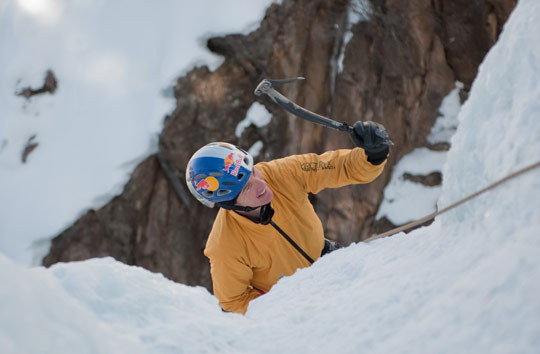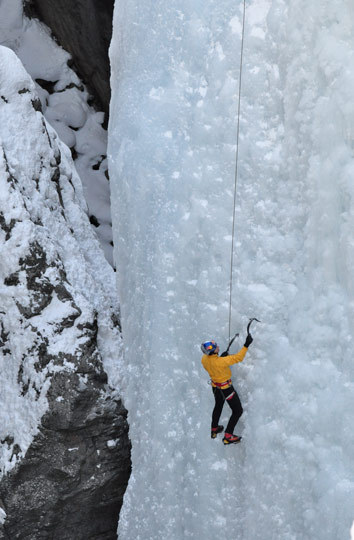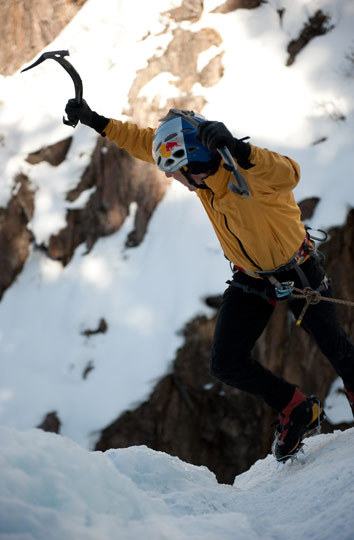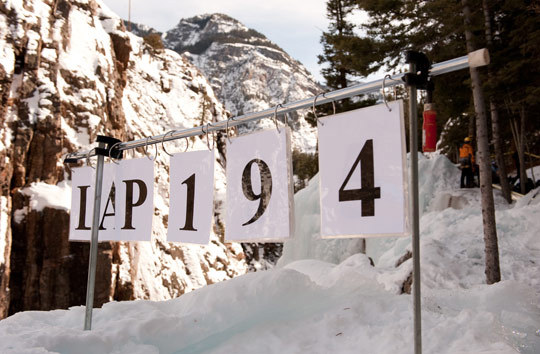
Will Gadd tops out an early lap during his 24-hour Endless Ascent marathon in Ouray Ice Park. Gadd climbed 194 laps–or 25,414′–on The Pic of the Vic (WI4) from noon January 9 to noon January 10 to raise money for the dZi Foundation. [Photo] James Beissel
From noon-to-noon on January 9-10, Will Gadd embarked on a personal challenge that few would ever try–let alone match. Will tested himself on an “endless ascent” of The Pic of the Vic (WI4) in the Ouray Ice Park, climbing as many laps as possible on the route in a 24-hour period to raise money for the dZi Foundation.
Will is a world-class climber from Canmore, Alberta. Though capable of competing with the best in the Ouray Ice Festival climbing competition, which took place that same day, Will chose to compete with himself against the clock. From the park’s upper bridge, onlookers watched the festival comp on one side and Gadd’s endless ascent on the other.
Even in the chilly wee hours of the night, spotlight on Will as he continued trudging upward, supporters came to give shouts of encouragement and bring coffee and pastries for Will. The next morning, Will was exhausted but still swinging his tools. At the noon cutoff he gasped for air, having climbed an astounding 194 laps–a minimum total of 25,414′–all in a single day.
“The height of the climb is at least 40 meters,” Gadd said. “It might be a fair amount more, but I’ll use the lowest number I can say with a straight face.” The event raised between $15,000-20,000 for the dZi foundation.
Alpinist caught up with Will after the event to ask him what it’s like to climb vertical ice for 24 hours straight.

Gadd on Lap 1. [Photo] James Beissel
1) How did you come up with the idea to do an “Endless Ascent”?
I had been talking with friends about the idea for about a year now, bouncing the idea around… I just really enjoy ice climbing. So, I thought, “Why not figure out how much I can do in a day?” It proved harder than I thought it would be.
2) You climbed more than 25,000 vertical feet. What was your original goal?
My first goal was to climb nonstop for a full day. If I could keep swinging my tools for 24 hours, I knew I would be giving it my best. Even if I had to tape my arm to my head, I just wanted to keep moving.
As far as height goes, I put my goal on the Endless Ascent website: I hoped to do 11,429′ or about 87 laps–the distance from base camp to summit on Everest. That’s a huge, huge day, much more than I had ever done in the past. I had done the math and figured there was no way I could climb 29,029′, the equivalent of sea level to summit. And based on my training sessions, I didn’t think it was possible, even on a good day, for me to climb more than about 15,000 feet. But I more than doubled what I hoped to do. I’m psyched.
3) How did you train, both physically and mentally, for this event?
Physically, I just did a whole lot of laps. I built a 16-foot “plycicle,” an icicle made of plywood, up in my yard here in Canmore and did hundreds if not thousands of laps on that thing. I really believe in training as closely as possible to the goal: rock climbing to train for rock climbing, ice climbing to train for ice climbing. The “plycicle” was reasonably close, but as soon as the ice came in, I was going out climbing with friends in the canyons around Canmore. I didn’t know there would be any lights during the event, so I also did a reasonable amount of climbing in the dark as part of my training.
4) What was most difficult about the Endless Ascent for you?
Physically, I had problems, and keeping it together mentally is tough when everything hurts. It’s just hard to keep moving for that long. If you think about doing anything for 24 hours, well, it’s pretty difficult.
But it was survivable. And, even at the end, when I was completely exhausted, there was motivation. I knew that every dollar we raised would have a huge effect in Nepal. I’m not a huge save-the-world guy, but I am happy to be involved in something meaningful.
5) What inspired you to raise money for the dZi Foundation’s Revitalize a Village Program?
I’ve seen Jim Nowak’s work in Nepal. What they’re doing is not just putting in water pumps–they’re creating community-based solutions. I like the idea that dZi is thinking through total solutions instead of partial solutions. That’s a philosophical difference that’s worthy. And they’re good people. Everyone I’ve met who’s involved with dZi is the kind of person I’d invite over for dinner and a glass of wine, and that means a lot to me.
Editor’s Note: Learn more about the dZi Foundation by visiting dzifoundation.org
6) You climbed a single route, The Pic of the Vic, nearly 200 times in a 24-hour period. Did that route have special significance to you before the event?
About 10 years ago, I did eight laps on it one day, and I was completely destroyed. I remember thinking that those eight laps were pushing the absolute limit of what’s possible. Oh, how things change.
During the climb, I only fell off once in 194 laps. That means I should have been less secure, but I don’t like falling off ice climbs…

Gadd climbed through the night on his way to 194 laps. [Photo] James Beissel
7) How did you eat and drink during the Endless Ascent?
I’d eat Clif Shot Bloks while I was being lowered, and I kept water mixed with electrolytes at the top. After each lap I’d try to down about 100 milliliters of water. I went through 18 liters of water and a tub of electrolyte mix. I also tried everything from pizza to steak, with varying degrees of success.
8) Climbing nonstop must wear on your entire body. What started to fail first?
My stomach. I had a bit of a puking session in the bottom of the canyon around Lap 75 or so. I just couldn’t eat enough calories to keep up. All the ultra-athletes told me I would have to puke at some point, and that I should just do it and get over it.
9) While climbing, where did your mind wander?
I really wasn’t bored. I’m sure I never climbed the route the same way twice. There are so many possibilities with ice. When I was moving, I felt pretty good. It was when I stopped that I wanted to start puking. I was just happy that my body wasn’t falling apart.

Gadd raises his pick to a cheering crowd after an early lap on Saturday. [Photo] James Beissel
10) What was it like to climb next to the competition on Saturday?
It was fun. I got to turn around occasionally and cheer for my friends. The comp route looked really fun, especially at about hour three–I knew that competing would have been a lot easier for me to deal with mentally. That’s for sure. And when it ended and started to get dark, I was definitely envious of the competitors. They can go have dinner and drink a beer, I thought, and I get another Clif Blok and have to go back into the hole.
11) What was it like to finish at noon on Sunday?
The place went nuts; it was crazy. There were so many people, so much energy. I was gasping for air through a rasped throat and lungs. I could barely talk. I was really honored and fired up to be part of the ending. At the end I had to just sit there for a while, and I don’t remember much to be honest. I was so fried that I was just trying to keep it together.
12) Would you ever again subject yourself to this pain?
Nope. I don’t think so. But I’ve said the same thing about drinking tequila–who knows.
13) Did you celebrate afterward?
No! I celebrated by doing nothing, and that was fine. That felt just great.
14) What was the best part of your Endless Ascent?
The people. Climbing as much as I did–I’m happy with that accomplishment. But more important to me were all the folks who supported me along the way. I had 23 belayers in 24 hours, and there were hundreds more people who heckled and cheered.
Some day, I’ll forget the number of feet I climbed. But I’ll never forget the energy of all the people who were there. That’s the coolest part.
Alpinist thanks James Beissel for providing the excellent photography in this Feature.

The final tally. [Photo] James Beissel